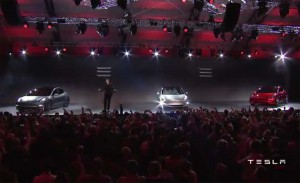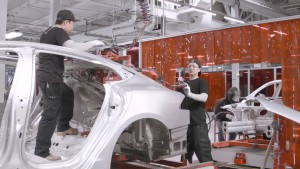Tesla is denying reports that it continues to face major manufacturing issues delaying the critical ramp-up of Model 3 production, an issue that could lead to a serious cash crunch in the months ahead.
The automaker launched its first mainstream, long-range model last July, but what CEO Elon Musk described as “production hell” resulted in serious delays last year, and according to new reports , production isn’t accelerating nearly as quickly as Musk and other senior executives had promised. Some of the biggest issues, according to company insiders quoted by CNBC, involve the Gigafactory plant in Nevada that produces batteries for the Model 3.
For its parts, Tesla is describing the report as “extremely misinformed and misleading,” and a statement added that, “To be absolutely clear, we are on track with the previous projections for achieving increased Model 3 production rates that we provided earlier this month.”
That said, the automaker confirmed one key point the reports had made, that “some elements of the production process” are still being handled manually, rather than using the special machinery that was supposed to put together the complex battery packs used in the Model 3 sedan.
Quoting unnamed Tesla insiders, CNBC reported that there have been numerous problems with that machinery requiring the battery-carmaker to continue doing much of the battery pack production work by hand, but also forcing Tesla to bring in additional workers from both its battery partner Panasonic and from temp agencies. And it noted that the complex and precise work is difficult to accomplish manually, resulting in high scrappage rates and the risk that some battery packs could fail in the field.
(Two Fed safety teams head to California crash probe. Click Here for the story.)
Tesla has a long history of over-promising and under-delivering. Its Model X electric SUV, for example, was originally scheduled to go on sale in 2014 but only reached showrooms two years later. And the vehicle has continued to face serious quality issues that led Consumer Reports last autumn to list it as the worst vehicle on the market, tied with the Cadillac Escalade, in its annual survey of vehicle owners.
CEO Musk had promised Tesla would roll out 1,600 Model 3 sedans during the third quarter of 2017, but the company managed to build just 220, largely by hand. Fourth quarter numbers also fell well short of expectations. But during a third-quarter earnings call, Musk and other execs promised production would reach 2,500 a week by the end of the first quarter of 2018 and 5,000 by the end of the second.
That would still be short of the goal of 10,000 a week needed to hit the 500,000 annual target from the Fremont plant – a figure that was expected to include about 100,000 Model S sedans and Model X SUVs.
Whether Tesla can even make its adjusted target remains uncertain, especially if the sources CNBC quoted are accurate. While there have been widely quoted problems at the Fremont plant with production of the Model 3 – which have resulted in extensive rework after the sedans come off the line – the biggest issue appears to be with the Gigafactory in Reno, Nevada.
The cable news outlet cited numerous Tesla insiders who said the company is struggling to put together Model 3 battery packs, balky automation forcing much of the work to be done by hand and, in many cases, by workers brought in from Panasonic or temp agencies. The batteries and cooling system have to be precisely aligned within each pack and that has caused delays and excessive scrappage, the report indicated.
In responding to the reports, Tesla did not say precisely how many Model 3s it is currently building. That figure could be revealed on Feb. 7, when the company issues its earnings report for the fourth quarter and all of 2017. It is generally expected to be a weak quarter, reflecting the high costs associated with the Model 3 launch and lower-than-anticipated production. The automaker also fell well short of Wall Street’s expectations during the third quarter.
(Click Here for more on how Americans feel about self-driving vehicles.)
That has raised the growing specter that Tesla will have to return to the equity markets to raise more capital, an irony considering the continuing strength of its stock.
But while there remain many bulls, there are growing concerns among analysts wary of the automaker’s continuing problems. CFRA analyst Efraim Levy reiterated his “Sell” recommendation this week. And Mark B. Spiegel, of Stanphyl Capital, warned, “Sales will hugely disappoint relative to expectations of over 400,000 a year,” adding that, “Tesla will never come close to its promised profitability.”
Musk has to hope the bears are wrong. The company announced a new, at-risk compensation plan for the CEO and Tesla founder this week. He will receive no pay or benefits unless and until a series of aggressive goals are met, including one that calls for a market capitalization of $650 billion. That would be more than a dozen times what the current market cap is, even though Tesla shares already trade at around $340 compared to $43 for General Motors – both as of mid-morning Friday.
If Tesla does meet its goals, however, Musk’s payout could climb into the tens of billions of dollars and make him, according to some estimates, one of the world’s richest men.
Production snags aren’t the only potential obstacle, however. Tesla is facing an unprecedented assault from both new and traditional competitors. GM, for one, plans to have 20 all-electric models on sale by 2023, Volkswagen targeting 40 models by 2025.
Then there’s the news that two separate federal safety agencies have sent investigators to California to learn why a Tesla Model S drove into the back of a parked firetruck on Interstate 405 in suburban Los Angeles Monday while operating on Autopilot.
(To see more about Tesla holding Musk to a higher standard for compensation, Click Here.)
The semi-autonomous system was given much of the blame by the National Transportation Safety Board for a May 2016 crash that killed a former Navy SEAL in Florida. Tesla said it updated the technology later that year, but it could face serious problems if the new version of Autopilot takes blame in the latest crash.



Tesla produces more fake news than the NY Times and WASH Post put together.
LMFAO…but certainly not as much as the White House, I would hope you might add, Kent…